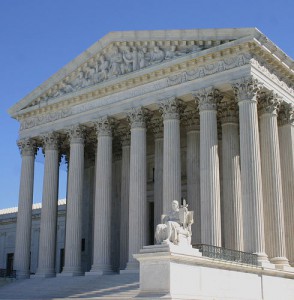Remembering the Glory Days of Church-State Separation

June 17 marks the 52nd anniversary of the landmark Supreme Court case, Abington School District v. Schempp, that declared unconstitutional a state law requiring public schools to start each day with a reading from the Bible. Coming just a year after the court’s Engel v. Vitale decision prohibiting school-sponsored prayer, the 1963 Abington case arguably marks the high point for church-state separation in the United States. There have been some important subsequent victories, of course, but never has the general consensus on Establishment Clause jurisprudence been stronger than during the early sixties, when even the nation’s president, John F. Kennedy, unambiguously explained his view this way: “I believe in an America where the separation of church and state is absolute.”
Many humanists are familiar with Ellery Schempp, who as a student in 1956 objected to Bible reading in his Pennsylvania high school. Schempp, an entertaining and informative speaker, has addressed humanist groups all around the country, telling the story behind the dispute that would eventually make its way to the nation’s highest court. Though the case would also involve many of his family members, it all started when young Ellery defiantly brought a copy of the Koran to class, refusing to participate in Bible recitation.
In law, as in life, timing is everything, and the Abington case was heard by the Supreme Court at a time when the concept of church-state separation had tremendous momentum. Out of political necessity, President Kennedy, the nation’s first Catholic commander in chief, emphasized the importance of keeping religion and government separate, and the nation’s high court agreed. The Warren Court had shocked the country a year earlier with the Engel ruling, a decision that conservatives still point to today as evidence that America has “kicked God out of schools.” Despite public criticism of Engel, or perhaps because of it, the court used the Abington case to drive home the point that public schools are not a forum for the promotion of religion.
In a definitive 8-1 ruling, the Supreme Court in Abington stressed that government cannot take sides on matters of religion. Emphasizing America’s pluralistic religious landscape, the majority opinion written by Justice Tom Clark pointed out that the country had at least eighty-three separate, large religious groups (of over fifty thousand members each) and many more that were smaller, thus making the selection of one religious text for public school use impractical and unwise. In such an environment, Clark wrote, “the State is committed to a position of neutrality.”
The Abington decision is one of the relatively rare Supreme Court cases where a concurring opinion (in this case written by Justice William Brennan) often draws more attention than the majority ruling itself. Brennan, going on for over seventy pages, provided a detailed historical analysis and argued against the notion of trying to determine how the framers would interpret the situation. “A too literal quest for the advice of the Founding Fathers upon the issues of these cases seems to me futile and misdirected,” he wrote.
An interesting side note in the Abington case, despite its pro-secular ruling, is an anti-atheist bias that was demonstrated by Justice Clark. Kevin M. Kruse, in his new book One Nation Under God: How Corporate America Invented Christian America, points out that Abington was joined with a companion case, Murray v. Baltimore School Commissioners, that had been brought by the infamous atheist Madalyn Murray. Attempting to craft an opinion that would preempt criticism, Clark “worked to push Madalyn Murray out of the spotlight,” Kruse writes. “According to standard practice, Murray should have been the captioned plaintiff, as her case had been placed on the docket first. But Clark knew that having an outspoken atheist as the face of the case would be toxic,” so he instead placed the Unitarian Schempp family as lead plaintiffs for captioning and opinion-writing purposes.
Thus, not surprisingly, even at the height of pro-secular jurisprudence, atheists found themselves pushed to the margins.
Another takeaway from any fair consideration of the glory days of the Warren Court is the outlandishness of the idea that God had been kicked out of public schools. Contrary to popular opinion, Engel and Abington did nothing to prohibit prayer or Bible reading in schools, but rather simply prohibited school-sponsored prayer and Bible reading. In fact, as author Katherine Stewart demonstrates in her compelling 2012 book, The Good News Club: The Christian Right’s Stealth Assault on America’s Children, religion has never been more entrenched in US public schools than it is today, as Christian clubs proliferate and, in many areas, Christian churches utilize public school buildings. In reality, while Engel and Abington live on as valid precedents, the religious right has done everything possible to assure that Christianity continues to permeate public education.
If anything is going to turn this around, we’ll most likely need some new Ellery Schempps. Thankfully, as the AHA is discovering in its popular Pledge Boycott, there are many young people across the nation who are standing up as proudly secular and willing to challenge the promotion of religion in their schools.
